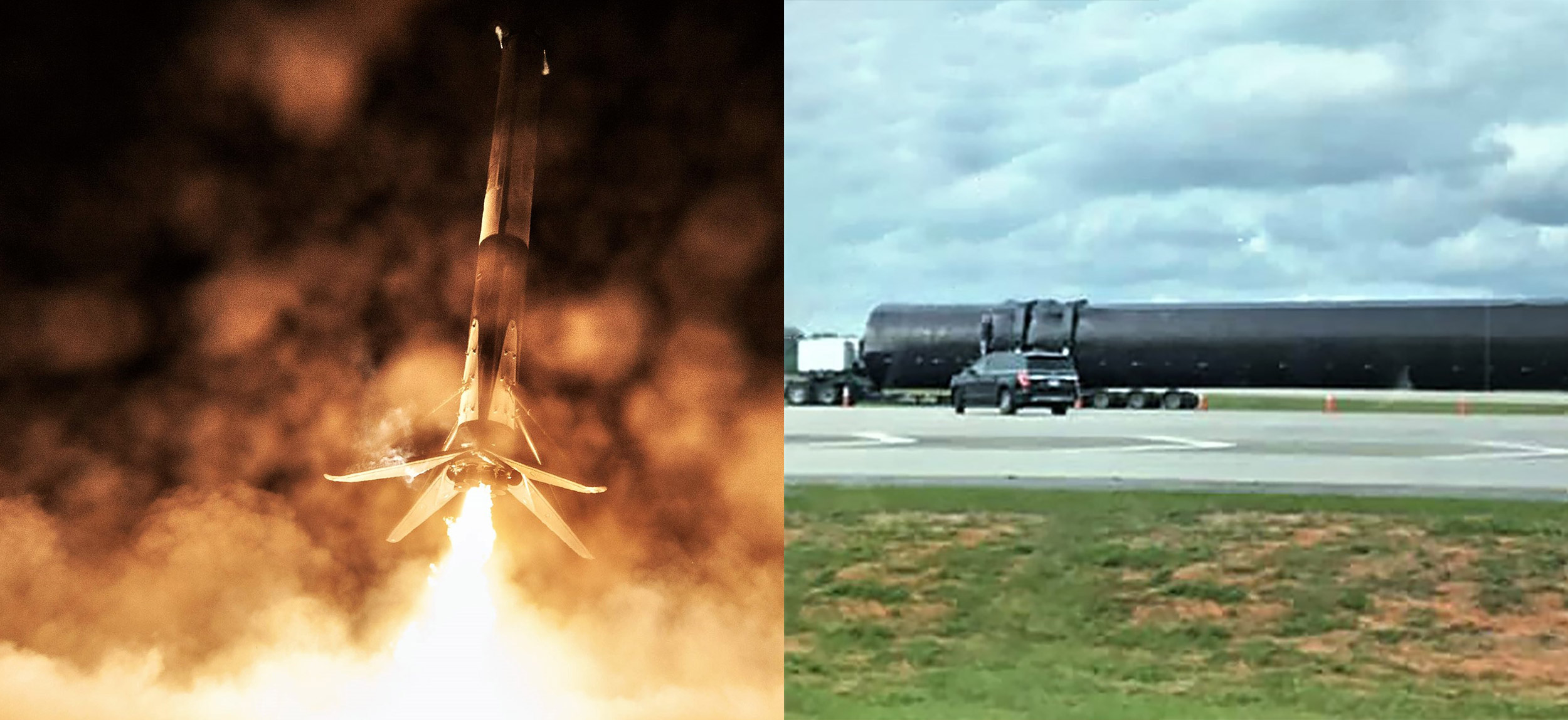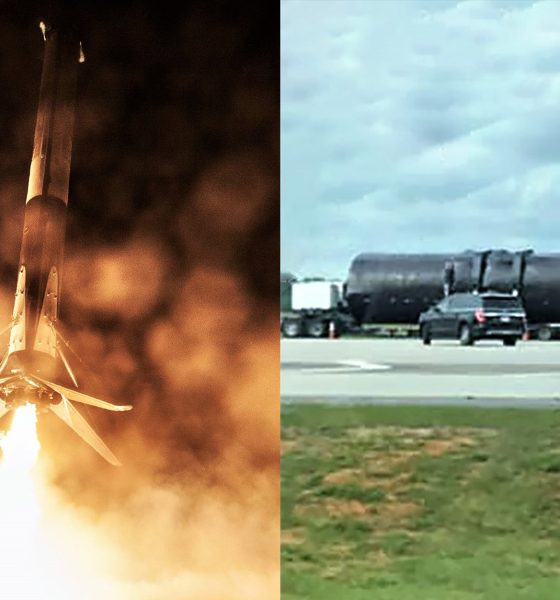

News
SpaceX ships Falcon 9 booster west for second California launch of 2019
A local resident spotted a SpaceX Falcon 9 booster heading west out of Florida, likely bound for the company’s SLC-4E Vandenberg Air Force Base (VAFB) launch pad and second California launch of 2019.
Barring a surprise reassignment, the booster Joshuah Murrah caught is Falcon 9 B1051, on its way west some 50 days after successfully supporting Crew Dragon’s March 2nd launch debut. Despite the availability of B1046, B1047, and B1049, B1051 was assigned to the Canadian Space Agency’s (CSA) Radarsat Constellation Mission (RCM) shortly after landing aboard OCISLY, triggering major launch delays. The most logical explanation for customer CSA’s and satellite contractor Maxar Technologies’ curious decision is that they must believe that Falcon 9 Block 5 boosters with more than one launch in their past add more risk than those that do not.
According to an April 16th update from CSA, RCM’s launch was scheduled for no earlier than (NET) late May or early June, although word on the ground is that mid-to-late June is now a more likely target. Contrary to rumors of delays, B1051’s shipment west indicates that SpaceX has more or less completed the booster’s refurbishment, likely the easiest Falcon 9 Block 5 refurbishment yet thanks to its relatively slow and cool reentry after launching Crew Dragon.
B1051 returned to Pad 39A’s integration hangar around March 7th, where it spent approximately 50 days being inspected, refurbished, and prepared for cross-country transport. The booster departed Florida on April 26th and will likely arrive at VAFB around May 2nd. Even assuming a slow trip west and buggy preflight preparations, Falcon 9 should theoretically be ready to launch RCM no later than the third or fourth week of May, barring issues or production delays with the mission’s fairing or Falcon upper stage.

Given that Maxar/CSA chose B1051 at a cost of months of launch delays, they may have needs that far outstretch the normal demands of SpaceX’s private (non-government) customers, not out of the question given that CSA is a national space agency and RCM is a high-value (~$1B) science mission. Short of flying on a new Falcon 9 booster, B1051 does theoretically seem to offer the least risk of failure insofar as one can claim that boosters that have completed more launches are more likely to fail.
SpaceX would likely vehemently deny such a claim given their position that highly reusable rockets – much like aircraft – will actually become more reliable and trustworthy the more they launch. Both positions make sense in theory but theory falls flat in the face of actual data, of which only SpaceX and certain customers have access to.
As an external observer, the best data available is a binary public record of Falcon 9 launch success, as well as the degree to which missions are delayed beyond their scheduled launch targets. Falcon 9 Block 5 boosters have launched 16 times in 11 months, six of which used a flight-proven first stage. Flight-proven boosters appear to be a bit more finicky than unflown rockets in terms of late-stage launch delays, but the data is inconsistent and the sample size statistically insignificant. More generally, Falcon 9 and Falcon Heavy have launched 72 times in nine years and suffered two total failures, both caused by unflown upper stages. In 72 launches, including 20 missions with flight-proven boosters, a Falcon 9/Heavy first stage has never caused a total mission failure.
In short, it’s impossible to intuit any clear performance or reliability advantage without the sort of granular per-mission data that only SpaceX and privileged customers have access to. In general, Falcon 9 – reused or not – has consecutively completed 41 successful launches since its second and last mission failure in September 2016, half (49%) of which used flight-proven boosters. Of course, customers have every right to their own standards and expectations of quality and risk-reduction, but Falcon 9’s performance largely speaks for itself at this point – anything beyond its default record of mission assurance is just icing on the proverbial spaceflight cake.
Check out Teslarati’s Marketplace! We offer Tesla accessories, including for the Tesla Cybertruck and Tesla Model 3.

Cybertruck
Tesla Cybertruck undergoes interior mod that many owners wanted

Tesla Cybertruck is significantly different from traditional pickups on the market in a lot of ways. However, one feature that was recently modified with its interior was a highly requested characteristic that is present in other trucks, but was void from Cybertruck.
Tesla went with a five-seat configuration with Cybertruck: two in the front and three in the back. The spacious interior is matched with plenty of storage, especially up front, as a pass-through, center console, and other storage options, but some Tesla fans wanted something different: bench seating.
Bench seating is popular in many full-size pickups and allows three passengers to sit up front. The middle seat is usually accompanied by a fold-down storage unit with cupholders.
Tesla decided to opt for no bench seating up front, despite the fact that it equipped bench seating in the unveiling in 2019. Interior photos from the unveiling event from nearly six-and-a-half years ago show Tesla had originally planned to have a six-seat configuration.
This was adjusted after the company refined the design:

(Tesla Cybertruck interior configuration in 2019)
Despite Tesla abandoning this design, it does not mean owners were willing to accept it. One owner decided to modify their Tesla Cybertruck interior to equip that third seat between the driver’s and passenger’s thrones.
The fit is snug, and while it looks great, it is important to remember that this does not abide byregulations, as it would require an airbag to be technically legal. Please do not do this at home with your own Cybertruck:
- Credit: @blueskykites
- Credit: @blueskykites
- Credit: @blueskykites
The Cybertruck is a popular vehicle in terms of publicity, but its sales have been underwhelming since first delivered to customers back in 2023. It’s hard to believe it’s been out for two-and-a-half years, but despite this, Tesla has not been able to come through on its extensive order sheet.
This is mostly due to price, as Cybertruck was simply not as affordable as Tesla originally planned. Its three configurations were initially priced at $39,990, $49,990, and $69,990. At release, Cybertruck was priced above $100,000.
This priced out many of those who had placed orders, which is the main reason Cybertruck has not lived up to its expectations in terms of sales. The adjustments to the specific features, like the removal of the bench seat, likely did not impact sales as much as pricing did.
This modification shows some creativity by Tesla owners, but also shows that the Cybertruck could always be the subject of a potential refresh to include some of these features. Tesla routinely adjusts its vehicle designs every few years, so maybe the Cybertruck could get something like this if it chooses to refresh its all-electric pickup.
Elon Musk
Tesla CEO Elon Musk drops massive bomb about Cybercab
“And there is so much to this car that is not obvious on the surface,” Musk said.

Tesla CEO Elon Musk dropped a massive bomb about the Cybercab, which is the company’s fully autonomous ride-hailing vehicle that will enter production later this year.
The Cybercab was unveiled back in October 2024 at the company’s “We, Robot” event in Los Angeles, and is among the major catalysts for the company’s growth in the coming years. It is expected to push Tesla into a major growth phase, especially as the automaker is transitioning into more of an AI and Robotics company than anything else.
The Cybercab will enable completely autonomous ride-hailing for Tesla, and although its other vehicles will also be capable of this technology, the Cybercab is slightly different. It will have no steering wheel or pedals, and will allow two occupants to travel from Point A to Point B with zero responsibilities within the car.
Tesla shares epic 2025 recap video, confirms start of Cybercab production
Details on the Cybercab are pretty face value at this point: we know Tesla is enabling 1-2 passengers to ride in it at a time, and this strategy was based on statistics that show most ride-hailing trips have no more than two occupants. It will also have in-vehicle entertainment options accessible from the center touchscreen.
It will also have wireless charging capabilities, which were displayed at “We, Robot,” and there could be more features that will be highly beneficial to riders, offering a full-fledged autonomous experience.
Musk dropped a big hint that there is much more to the Cybercab than what we know, as a post on X said that “there is so much to this car that is not obvious on the surface.”
And there is so much to this car that is not obvious on the surface
— Elon Musk (@elonmusk) January 2, 2026
As the Cybercab is expected to enter production later this year, Tesla is surely going to include a handful of things they have not yet revealed to the public.
Musk seems to be indicating that some of the features will make it even more groundbreaking, and the idea is to enable a truly autonomous experience from start to finish for riders. Everything from climate control to emergency systems, and more, should be included with the car.
It seems more likely than not that Tesla will make the Cybercab its smartest vehicle so far, as if its current lineup is not already extremely intelligent, user-friendly, and intuitive.
Investor's Corner
Tesla Q4 delivery numbers are better than they initially look: analyst
The Deepwater Asset Management Managing Partner shared his thoughts in a post on his website.

Longtime Tesla analyst and Deepwater Asset Management Managing Partner Gene Munster has shared his insights on Tesla’s Q4 2025 deliveries. As per the analyst, Tesla’s numbers are actually better than they first appear.
Munster shared his thoughts in a post on his website.
Normalized December Deliveries
Munster noted that Tesla delivered 418k vehicles in the fourth quarter of 2025, slightly below Street expectations of 420k but above the whisper number of 415k. Tesla’s reported 16% year-over-year decline, compared to +7% in September, is largely distorted by the timing of the tax credit expiration, which pulled forward demand.
“Taking a step back, we believe September deliveries pulled forward approximately 55k units that would have otherwise occurred in December or March. For simplicity, we assume the entire pull-forward impacted the December quarter. Under this assumption, September growth would have been down ~5% absent the 55k pull-forward, a Deepwater estimate tied to the credit’s expiration.
“For December deliveries to have declined ~5% year over year would imply total deliveries of roughly 470k. Subtracting the 55k units pulled into September results in an implied December delivery figure of approximately 415k. The reported 418k suggests that, when normalizing for the tax credit timing, quarter-over-quarter growth has been consistently down ~5%. Importantly, this ~5% decline represents an improvement from the ~13% declines seen in both the March and June 2025 quarters.“
Tesla’s United States market share
Munster also estimated that Q4 as a whole might very well show a notable improvement in Tesla’s market share in the United States.
“Over the past couple of years, based on data from Cox Automotive, Tesla has been losing U.S. EV market share, declining to just under 50%. Based on data for October and November, Cox estimates that total U.S. EV sales were down approximately 35%, compared to Tesla’s just reported down 16% for the full quarter. For the first two months of the quarter, Cox reported Tesla market share of roughly a 65% share, up from under 50% in the September quarter.
“While this data excludes December, the quarter as a whole is likely to show a material improvement in Tesla’s U.S. EV market share.“














